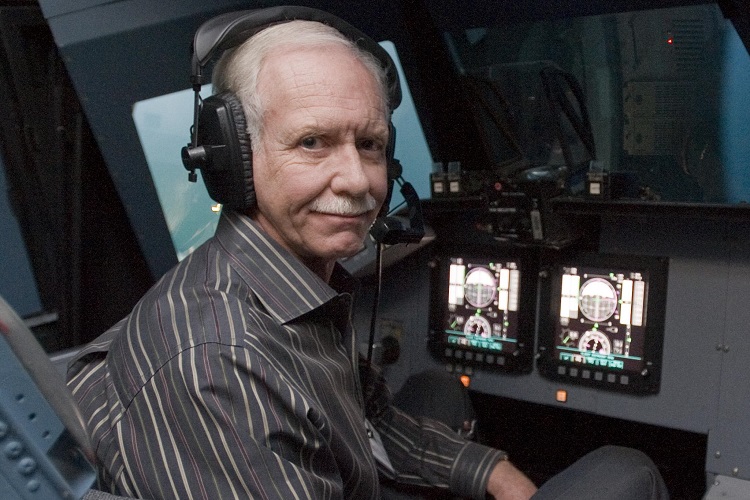

Captain Chesley Sullenberger visits the Virtual Motion Simulator at the NASA Ames Research Center in Moffett Field, California. (Photo by Eric James.)
By Todd J. LeDuc
I recently spent a couple of quiet hours enjoying the wonderful movie “Sully,” directed by Clint Eastwood and starring Tom Hanks as Captain Chesley Sullenberger, which recreated the events that led to Sullenberger’s water landing of a commercial airliner onto the icy Hudson River on January 15, 2009, with all the souls on board surviving.
For any seasoned traveler, you could not help but get goosebumps imagining what was going through everyone’s mind as the Captain announced “brace for impact” to passengers as they were coached over and over again to assume the “crash position.”
RELATED: Ray on Preparation: Key to Success for Volunteers ‖ Heller on Are We Prepared to Slide the Floor? ‖ Pronesti on Preparing for the “Main Street” Mayday
The following lessons learned from the “Miracle on the Hudson” are directly applicable to fire service scenarios.
- Experience and training are paramount! We learn through experiential exposures that show us what works and what does not. We train for high-risk, low-frequency events so we will perform as we trained during the actual time of crisis. This includes studying the National Institute for Occupational Safety and Health’s (NIOSH’s) firefighter fatality reports and drilling on high-risk, low-frequency events such as a collapse, Maydays, lost firefighter. I recently visited the training academy of one of our nation’s largest fire departments. Not only did they put the entire department through the International Association of Fire Fighters/International Association of Fire Chiefs fireground survival training with all the associated props and scenarios, but they also put all command chiefs through simulated and interactive scenarios that may be infrequently encountered but are critical to get right for our survival.
- Stay calm. Your body reacts to stress by releasing your “flight or fight” sympathetic nervous system response. This releases adrenaline and stress hormones into your blood stream, elevating your pulse rate, breathing, and blood pressure; over-driven, parasympathetic responses that can affect decision making. Counterbalance this reaction with slow, deep breathing.
- Communicate clearly! In the movie, we all hear Captain Sully clearly and succinctly declare their in-flight emergency, request what he needed (i.e., an immediate landing spot), and concisely detail his alternate course of action—a Hudson water landing. Many fireground NIOSH investigative reports continue to detail the challenges of fireground communications when something goes wrong. Prepare a canned communications report in your mind, such as who and where you are, what the emergency is, and what you need. Again, the time to prepare and practice is daily.
- Follow the list! Punch lists are crucial job aids that make critical tasks and necessary action steps that are essential; they are to be completed in situations that are infrequent, potentially catastrophic, and high risk. We see Captain Sully and his co-pilot quickly go through a punch list of actions necessary to safely prepare for a water landing or double engine loss.
- Teamwork is critical. We see that although Captain Sully was the pilot in command during this historical event, it took a team to coordinate the actions to make this event successful where no lives were lost. The co-pilot, flight attendants, and even other passengers assisting each other. On the fire ground, it takes a well-trained and coordinated team that clearly understands their tasks.
Whether career or volunteer, all firefighters will likely face a high-risk, low-frequency, or potentially catastrophic event or sequence of events. Captain Sully and his team spent their lives preparing for one. Have you and your team done the same?
RELATED: US Airways Flight 1549: New York Marine Operations | US Airways Flight 1549: New Jersey Rescue Operations
Todd J. LeDuc, MS, CFO, CEM, FIFirE, is a 27-year veteran of and an assistant chief with Broward County (FL) Fire Rescue, an internally accredited metro fire department. He is also the secretary of the International Association of Fire Chief’s Association Safety, Health & Survival Board. He has a master’s degree in executive fire service leadership, is a peer reviewer for agency accreditation and professional credentialing. He is a credentialed chief officer, a certified emergency manager, and a fellow in the Institute of Fire Engineers. You can reach LeDuc by email at tjlbcems@aol.com.

